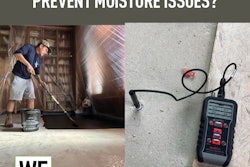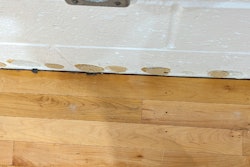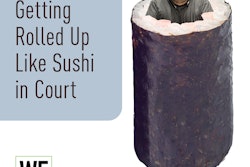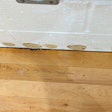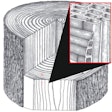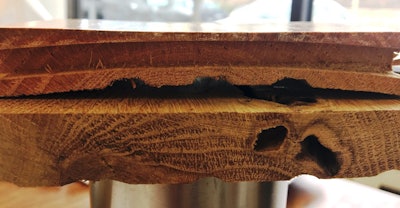
Here we go again! Strap on your knee pads and let’s dive right in.
Russel Lunt from New Hampshire Wood Flooring LLC stopped in with some flooring samples torn out of a repair job. Examine what I am calling the “Ouchwood” photos. From this photo could you, in 30 words or less, describe exactly what happened with this floor? Take a look:

The floor always tells the story. The additional photos all add to the story, so take a good look:


I hear it all the time: “It’s flooring, not rocket science!” Well, it may not be rocket science, but it takes a seasoned floor pro to look at a photo or piece of wood and know almost every detail regarding a floor system’s performance. When I go out to inspect a floor there are often upset consumers, angry dealers, abused floor guys, and sometimes even attorneys. I get out there as soon as possible and, fairly but firmly, provide answers and possible solutions. I had a colleague who used to say, “Bring ’em the ‘Shock and Awe,’ baby!” as I dashed off with my extensive cache of fancy inspection gadgets. Shock and Awe can rapidly become more Chaka Khan when keepin’ it real goes wrong, trust me! (That’s a lame ’70s pop/disco reference, couldn’t resist!)
Let’s go over some basic questions. If you examined the photos, here is what you should have identified:
What species is the floor? In the photos there are two different wood species: 5” plank red oak and white oak. The red oak is from the job site and the white is for visual comparison to the manufacturer’s intended dimensions.
Was this floor glued or glue-assisted? No. The photos show black staining on the back indicative of asphalt paper/roofing felt. The black stripes on the subfloor are the imprint of the hollow-back left by the asphalt paper. If there was asphalt paper, it’s unlikely there was adhesive.
Should this floor have been glued down or at least glue-assisted? That's open for debate, but 5” is the tipping point for most installers and technical manuals. The installer did choose to use adhesive on the new installation, especially seeing the home is on the water (also visible in one of the photos).
What is the subflooring material, exactly? Look closely … it’s Advantech.
What fasteners were used? They are 1/2” crown, 2” standard staples. So, between the hardwood floor milling, Advantech, staples, underlayment and other clues in the photos, we can surmise this floor met current installation standards. And we can see the Advantech performed well even under adverse conditions as demonstrated by the staples that still hold tight in the subfloor after the oak was removed. That subfloor will be fine for round two.
Why is there flooring around the perimeter? The contractor doing the repair work was clearly trying to save some of the original installation to possibly tie-in with new material and start off existing lines to maintain the layout of the original floor. The rip cut photo indicates the point where the rip up started. In looking at the photos, you can see the cause for removal was water damage. This is a $1 million flip renovation of a summer home on Lake Winnipesaukee in New Hampshire, so critical decisions had to be made.
The biggest reveal here is the red oak sample in the first photo. This is where your 30 words or less diagnosis comes in. This hardwood floor was installed properly at some point (FYI, it measures accurately). The 5” plank appears flat and even on the surface, but the bottom side of the boards are convex.
Here’s my suggested 30-words diagnosis:
This floor was cupped. It was sanded in an attempt to flatten it. The floor dried and crowned. Then, the floor was sanded again in order to flatten the crowns.
Russ Lunt says there were two leaks at different times. One from a refrigerator (you can see the water stains by the sink area) and one from a wash room. Lunt told me the floor did cup after the refrigerator leaked and a pipe in the laundry room failed. The owner had the floors sanded and finished, and they looked great. The floor has a radiant heat system, and when it was turned on, the floor began to crown dramatically. The floor was sanded again, and parts of it have the flat appearance you see in the photos. However, other areas remained crowned. The owner had the floor replaced properly (including adhesive), sanded and finished by Lunt prior to listing the home for sale.
Before this job started, Lunt was able to measure the original flooring, as it appeared to be ¾” thick and fairly flat in some areas. Once boards were removed, as in our first photo, the flooring showed minimal wear on the tongue and groove sides, but the middle was only ½”! Sanding the cupped floor was bad enough, but when the crowned floor was sanded, a massive amount of material was removed, giving the flooring its hourglass shape. Also notice the ¼” wear layer is down to less than 1/16”.
In this situation, Lunt brought samples to his distributor (us!) for additional opinions before considering the owners request to sand the floor yet again! He astutely came to the conclusion that a rip up and installation of a new floor was the best course of action. He informed his customer, who agreed. The new floor looks fantastic.
Bonus: Did anyone notice the Gothic cross in the round shadow that no one can explain? Take another look on the subfloor. The cross lies under a new layer of red oak now, never to be seen again … unless …
Stay well, all, and please share your flooring “shocket science” with us!
Mill logs and prosper, floor guys!
See more wood floor mysteries from Stephen Diggins:
Wood Floor Mystery #1: The Spreading Black Spots
Wood Floor Mystery #2: The Poly That Wouldn't Stick
Wood Floor Mystery #3: The Tale of the Half-Cupped Floors, Part 1
Wood Floor Mystery #5: The Uniform Gaps
Wood Floor Mystery #6: The Case of the Crawling Finish
Wood Floor Mystery #7: The Case of the ‘Burned’ Floor
Wood Floor Mystery #8: Is This Floor Fungus Among Us?
















